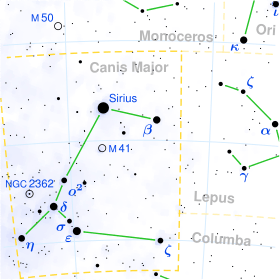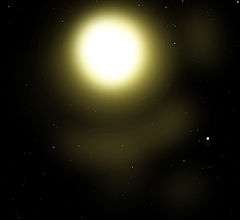Delta Canis Majoris
Delta Canis Majoris (Latinised from δ Canis Majoris, abbreviated Delta CMa, δ CMa), officially named Wezen /ˈwiːzən/,[10] is a star in the constellation of Canis Major. It is a yellow-white F-type supergiant with an apparent magnitude of +1.83. Since 1943, the spectrum of this star has served as one of the stable anchor points by which other stars are classified.[11]
 | |
| Observation data Epoch J2000 Equinox J2000 | |
|---|---|
| Constellation | Canis Major |
| Right ascension | 07h 08m 23.48608s[1] |
| Declination | −26° 23′ 35.5474″[1] |
| Apparent magnitude (V) | 1.824[2] |
| Characteristics | |
| Spectral type | F8 Ia[3] |
| U−B color index | +0.584[2] |
| B−V color index | +0.691[2] |
| Variable type | ?[4] |
| Astrometry | |
| Radial velocity (Rv) | 34.3 ± 0.9[5] km/s |
| Proper motion (μ) | RA: –3.12[1] mas/yr Dec.: +3.31[1] mas/yr |
| Parallax (π) | 2.03 ± 0.38[1] mas |
| Distance | approx. 1,600 ly (approx. 490 pc) |
| Absolute magnitude (MV) | –6.86[6] |
| Details | |
| Mass | 16.9 ± 1.6[3] M☉ |
| Radius | 215 ± 66[7] R☉ |
| Luminosity | 82,000[6] L☉ |
| Surface gravity (log g) | 1.00 ± 0.14[3] cgs |
| Temperature | 6,390 ± 150[3] K |
| Metallicity [Fe/H] | 0.24[8] dex |
| Rotational velocity (v sin i) | 25[9] km/s |
| Age | 12[3] Myr |
| Other designations | |
Wezen, Wesen, Wezea, Alwazn, Al Wazor, 25 Canis Majoris, CD−263916, FK5 273, HD 54605, HIP 34444, HR 2693, SAO 173047. | |
| Database references | |
| SIMBAD | data |
Observation
Delta Canis Majoris is the third-brightest star in the constellation after Sirius and ε Canis Majoris (Adhara), with an apparent magnitude of +1.83, and is white or yellow-white in colour. Lying about 10 degrees south southeast of Sirius, it only rises to about 11 degrees above the horizon at the latitude of the United Kingdom.[12] The open cluster NGC 2354 is located only 1.3 degrees east of Delta Canis Majoris.[13] As with the rest of Canis Major, Delta Canis Majoris is most visible in winter skies in the northern hemisphere, and summer skies in the southern. In Bayer's Uranometria, it is in the Great Dog's hind quarter.[14]
History and naming
δ Canis Majoris (Latinised to Delta Canis Majoris) is the star's Bayer designation.
The traditional name, Wezen (alternatively Wesen, or Wezea), is derived from the medieval Arabic وزن al-wazn, which means 'weight' in modern Arabic. The name was for one of a pair of stars, the other being Hadar, which has now come to refer to Beta Centauri. It is unclear whether the pair of stars was originally Alpha and Beta Centauri or Alpha and Beta Columbae. In any case, the name was somehow applied to both Delta Canis Majoris and Beta Columbae.[15] Richard Hinckley Allen muses that the name alludes to the difficulty the star has rising above the horizon in the northern hemisphere.[14] Astronomer Jim Kaler has noted the aptness of the traditional name given the star's massive nature.[16]
In 2016, the International Astronomical Union organized a Working Group on Star Names (WGSN)[17] to catalog and standardize proper names for stars. The WGSN's first bulletin of July 2016[18] included a table of the first two batches of names approved by the WGSN; which included Wezen for this star.
In Chinese, 弧矢 (Hú Shǐ), meaning Bow and Arrow,[19] refers to an asterism consisting of δ Canis Majoris, ε Canis Majoris, η Canis Majoris, κ Canis Majoris, ο Puppis, π Puppis, χ Puppis, c Puppis and k Puppis. Consequently, δ Canis Majoris itself is known as 弧矢一 (Hú Shǐ yī, English: the First Star of Bow and Arrow.)[20]
In the catalogue of stars in the Calendarium of Al Achsasi Al Mouakket, this star was designated Thalath al Adzari (تالت ألعذاري - taalit al-aðārii), which was translated into Latin as Tertia Virginum, meaning the third virgin.[21] This star, along with ε Canis Majoris (Adhara), η Canis Majoris (Aludra) and ο2 Canis Majoris (Thanih al Adzari), were Al ʽAdhārā (ألعذاري), the Virgins.[22][23]
Physical properties

Delta Canis Majoris is a supergiant of class F8 with a radius around 215 times that of the Sun. Its surface temperature is around 5,818 K,[24] and it is 17 times more massive than the Sun. Its absolute magnitude is −6.87,[6] and it lies around 1,600 light-years away. It is rotating at a speed of around 28 km/s, and hence may take a year to rotate fully. Only around 10 million years old, Delta Canis Majoris has stopped fusing hydrogen in its core. Its outer envelope is beginning to expand and cool, and in the next 100,000 years it will become a red supergiant as its core fuses heavier and heavier elements. Once it has an iron core, it will collapse and explode as a supernova.[16]
If Delta Canis Majoris were as close to Earth as Sirius is, it would be as bright as a half-full moon.[25]
Modern legacy
Delta Canis Majoris appears on the flag of Brazil, symbolising the state of Roraima.[26]
References
- van Leeuwen, F. (November 2007). "Validation of the new Hipparcos reduction". Astronomy and Astrophysics. 474 (2): 653–664. arXiv:0708.1752. Bibcode:2007A&A...474..653V. doi:10.1051/0004-6361:20078357.
- Gutierrez-Moreno, Adelina; et al. (1966). "A System of photometric standards". Publ. Dept. Astron. Univ. Chile. Publicaciones Universidad de Chile, Department de Astronomy. 1: 1–17. Bibcode:1966PDAUC...1....1G.
- Lyubimkov, Leonid S.; et al. (February 2010). "Accurate fundamental parameters for A-, F- and G-type Supergiants in the solar neighbourhood". Monthly Notices of the Royal Astronomical Society. 402 (2): 1369–1379. arXiv:0911.1335. Bibcode:2010MNRAS.402.1369L. doi:10.1111/j.1365-2966.2009.15979.x.
- Koen, Chris; Eyer, Laurent (2002). "New periodic variables from the Hipparcos epoch photometry". Monthly Notices of the Royal Astronomical Society. 331 (1): 45–59. arXiv:astro-ph/0112194. Bibcode:2002MNRAS.331...45K. doi:10.1046/j.1365-8711.2002.05150.x. ISSN 0035-8711.
- Evans, D. S. (June 20–24, 1966). Batten, Alan Henry; Heard, John Frederick (eds.). "The Revision of the General Catalogue of Radial Velocities". Determination of Radial Velocities and their Applications. University of Toronto: International Astronomical Union. 30: 57. Bibcode:1967IAUS...30...57E.
- Arellano Ferro, A.; Giridhar, S.; Rojo Arellano, E. (April 2003). "A Revised Calibration of the MV-W(O I 7774) Relationship using Hipparcos Data: Its Application to Cepheids and Evolved Stars". Revista Mexicana de Astronomía y Astrofísica. 39: 3–15. arXiv:astro-ph/0210695. Bibcode:2003RMxAA..39....3A.
- Davis, J.; et al. (October 2007). "The Emergent Flux and Effective Temperature of δ Canis Majoris". Publications of the Astronomical Society of Australia. 24 (3): 151–158. arXiv:0709.3873. Bibcode:2007PASA...24..151D. doi:10.1071/AS07017.
- Prugniel, Ph.; Vauglin, I.; Koleva, M. (July 2011). "The atmospheric parameters and spectral interpolator for the MILES stars". Astronomy & Astrophysics. 531: A165. arXiv:1104.4952. Bibcode:2011A&A...531A.165P. doi:10.1051/0004-6361/201116769.
- Bernacca, P. L.; Perinotto, M. (1970). "A catalogue of stellar rotational velocities". Contributi Osservatorio Astronomico di Padova in Asiago. 239 (1): 1. Bibcode:1970CoAsi.239....1B.
- "IAU Catalog of Star Names". Retrieved 28 July 2016.
- Garrison, R. F. (December 1993). "Anchor Points for the MK System of Spectral Classification". Bulletin of the American Astronomical Society. 25: 1319. Bibcode:1993AAS...183.1710G. Retrieved 2012-02-04.
- Mobberly, Martin (2009). The Caldwell Objects and How to Observe Them. Springer. p. 136. ISBN 1-4419-0325-9.
- http://www.angelfire.com/ky/astronomers/Canis.html
- Allen, R H (1963) [1899]. Star Names: Their Lore and Meaning (rep. ed.). New York, NY: Dover Publications Inc. p. 130. ISBN 0-486-21079-0.
- Kunitzsch, Paul; Smart, Tim (2006). A Dictionary of Modern star Names: A Short Guide to 254 Star Names and Their Derivations (2nd rev. ed.). Cambridge, MA: Sky Pub. p. 23. ISBN 978-1-931559-44-7.
- Kaler, James B. "Wezen". Stars website. University of Illinois. Retrieved 28 May 2010.
- "IAU Working Group on Star Names (WGSN)". Retrieved 22 May 2016.
- "Bulletin of the IAU Working Group on Star Names, No. 1" (PDF). Retrieved 28 July 2016.
- 弧矢 (Hú Shǐ) is westernized into Koo She. R.H. Allen had opinion that Koo She refers to the asterism including δ Velorum and ω Velorum. AEEA opinion is, δ Velorum is member of 天社 (Tiān Shè), meaning Celestial Earth God's Temple asterism and ω Velorum is not member of any asterisms. 天社 (Tiān Shè) is westernized into Tseen She and R.H.Allen used the term Tseen She for Chinese name of η Carinae. See Richard Hinckley Allen: Star Names — Their Lore and Meaning: Argo Navis and (in Chinese) AEEA (Activities of Exhibition and Education in Astronomy) 天文教育資訊網 2006 年 7 月 17 日.
- (in Chinese) AEEA (Activities of Exhibition and Education in Astronomy) 天文教育資訊網 2006 年 7 月 17 日
- Knobel, E. B. (June 1895). "Al Achsasi Al Mouakket, on a catalogue of stars in the Calendarium of Mohammad Al Achsasi Al Mouakket". Monthly Notices of the Royal Astronomical Society. 55 (8): 429–438. Bibcode:1895MNRAS..55..429K. doi:10.1093/mnras/55.8.429.
- Allen, R. H. (1963). Star Names: Their Lore and Meaning (Reprint ed.). New York: Dover Publications Inc. p. 130. ISBN 0-486-21079-0. Retrieved 2010-12-12.
- ε CMa as Aoul al Adzari or Prima Virginum (the first virgin), ο2 CMa as Thanih al Adzari or Secunda Virginum (the second virgin) and δ CMa as Thalath al Adzari or Tertia Virginum (the third virgin). η CMa should be Rabah al Adzari or Quarta Virginum (the fourth virgin) consistently, but it was given by the name Aludra, meaning 'the virgin' (same meaning with Adhara (ε CMa) or Al ʽAdhārā)
- Davis, J.; Booth, A. J.; Ireland, M. J.; Jacob, A. P.; North, J. R.; Owens, S. M.; Robertson, J. G.; Tango, W. J.; Tuthill, P. G. (2013). "The Emergent Flux and Effective Temperature of δ Canis Majoris". Publications of the Astronomical Society of Australia. 24 (3): 151. arXiv:0709.3873. Bibcode:2007PASA...24..151D. doi:10.1071/AS07017.
- Ridpath, Ian; Tirion, Will (2003). The Monthly Sky Guide. Cambridge University Press. p. 16. ISBN 0-521-53306-6.
- "Astronomy of the Brazilian Flag". FOTW Flags Of The World website.